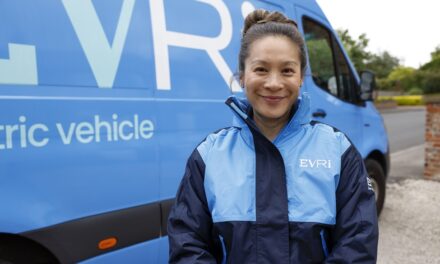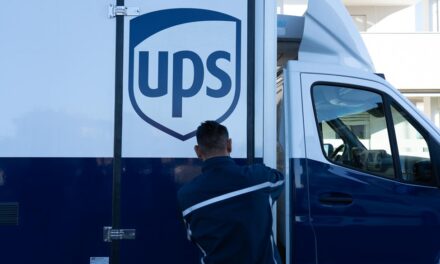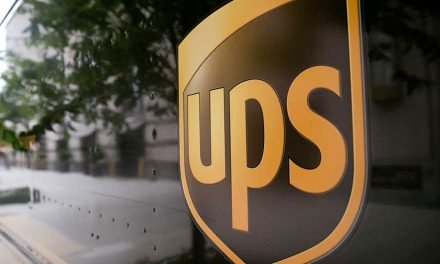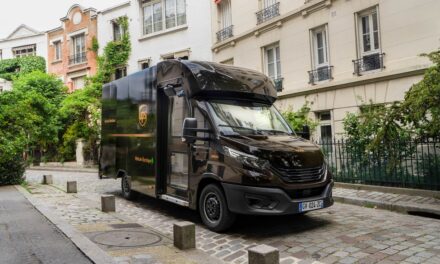
The electrification revolution

We speak to International Sustainability Director at UPS, Peter Harris, about improving the energy efficiencies associated with fleet electrification, the importance of technology in optimising sustainability efforts and how the COVID-19 pandemic has allowed us all to experience cleaner air.
Peter will be speaking about electrification at our virtual event Post&Parcel Live which will be held on 17-18 June 2020. Register for free today.
What drew you to your role at UPS?
From a technical perspective I have always been interested in the future of transportation – from playing with model cars as a child to reading engineering at university and beyond into my career at UPS. But my interest in the political and social aspects of where transportation was headed, and the need for it to be sustainable, came more gradually. Having children was a key turning point – what would the world look like for them in 30 years’ time? But also listening to the science and coming to realise just how serious climate change is for all of us.
What is the aim of your role?
It is my job to understand which of UPS’s effects on society are the most important and what to do about it. A lot of what we do is immediately beneficial and that’s great – we synchronise global commerce, we employ almost half a million people and we serve communities all over the world. But what we do also has unintended consequences – for example, we create emissions. As a responsible company we want to develop all the beneficial things further but also work on eliminating the unintended consequences. My job is to figure out how to achieve this balance.
What does sustainability personally mean to you?
I try to live sustainably. I work from home (and not just due to the coronavirus!) which means I don’t commute, and this eliminates all the emissions that commuting entails. I always use trains before planes when I travel. And I repair and recycle everything I can. But I won’t pretend it’s easy, and without doubt we need help from technology to overcome the challenges we face. That’s why I have chosen the topic of electrification for my presentation at Post & Parcel Live.
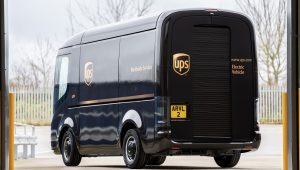 Where is UPS in terms of electrification?
Where is UPS in terms of electrification?
Experience gained in converting our diesel delivery vehicles to electric or hybrid has led to us making an investment in and ordering 10,000 electric vehicles from the technology company, Arrival. We’ve also introduced electrically assisted cargo cycles in several major European cities. This started with Hamburg, Germany, in 2012 and now includes Munich, Frankfurt, and Dublin. In each case deliveries by bike and on foot now help to reduce urban congestion and improve air quality.
Building on our legacy as an industry-leader in the electrification of last mile vehicles and our commitment for 25% of all new vehicle purchases to be alternative fuel or advanced technology in 2020, we are now adding heavy long-haul electric vehicles (EVs) to our fleet – 125 Tesla electric tractors are on order for use in the U.S. Looking further ahead we will move towards electrified aviation and complete integration with the energy sector.
Do you think the COVID-19 epidemic will change how logistic companies view electrification?
Yes, I think the COVID-19 pandemic has allowed us all to experience cleaner air and quiet streets for the past few weeks. We are also being increasingly led towards more sustainable urban planning, which more recently has included being actively encouraged by the UK government to cycle to work whilst limiting our use of public transport as we all attempt to return to work. This acceleration towards more cycle or pedestrian-centric solutions for cities could spark a long-term change in order to adapt to a new ‘normal’ post-pandemic.
Is electrification the key to meeting the e-commerce parcel boom?
Electrification is one of the keys. We also need efficiency, which is supported by a number of technologies such as big data ‘cloud computing’ solutions. However, efficiency alone will not reduce emissions, so we also need a technology shift. Electrification will be that shift, albeit with some bridging technologies, such as hybrid vehicles, which will be needed in the short and medium term.
How effective are electric vehicles with multi drop delivery routes?
Electric vehicles are very effective for multi-drop delivery work, as their zero emission at the tailpipe capability eliminates urban air pollution from the vehicle. In addition, we have seen a 65% reduction in greenhouse gas emissions ‘well to wheel’ with our conversion EVs, compared to the equivalent diesel, on standard grid electricity supply. Range is less of an issue in the urban environment than elsewhere, and because we operate a ‘back to base’ fleet we can do all our recharging overnight in the depot.
Our recent EFLES (EV Fleet Centred Local Energy Systems) is a great example of a smart grid solution that we’re using to charge vehicles when power is at its cheapest and cleanest by using onsite energy storage and solar power at the most cost-efficient times.
Many countries have to deal with peak season in cold/snowy conditions, how can they cope with demand using electric vehicles?
We find that batteries do lose some capacity in cold conditions, but at the same time they are constantly improving in terms of energy stored per kilogram of weight. For UPS, our experience with conversion EVs is that they have proven to work very well for us in all weather conditions.
What are the key obstacles to electrification?
The key obstacles we’ve faced previously when it comes to electrification are vehicle availability and cost. Our partnership with Arrival is one of the ways UPS has worked to overcome these obstacles, by creating purpose-built electric delivery vehicles that exactly match UPS’s specifications.
Another obstacle is power supply limitations into a building where an electric fleet is stationed and where it is recharged overnight. Our Smart Electric Urban Logistics (SEUL) project in London has been pivotal in helping UPS to overcome this challenge. Partnering with UK Power Networks, Cross-River Partnership and Innovate UK, SEUL enabled us to overcome the challenge of simultaneously re-charging an entire fleet of electric vehicles without the need for an expensive upgrade to the power supply grid by deploying the world’s first fleet scale combined smart-grid and energy storage solution.
What would you say to postal operators who are resistant to electrification?
It’s the future; we need to prepare as an industry to ensure we are ready to embrace the technology that will inevitably lead us to greater efficiency and more sustainable final mile solutions.
What are commons misconceptions about electric fleets?
Many people think electric vehicles are too expensive, aren’t yet available or have too little range. We’re proving this all wrong, for example through SEUL, or through our new project in London, EFLES. This new project, developed in partnership with Innovate UK, UK Power Networks Services, Cross River Partnership and Moixa, aims to demonstrate how the energy costs associated with fleet electrification can be reduced, for example, by optimising the timing of the purchase of electricity, or by selling it externally when not needed in-house.
What is your opinion on hybrid vehicles?
Hybrids are complicated and expensive but will be needed as a bridging technology for the short and medium term, in order to provide sufficient range for longer delivery routes. UPS has its own hybrids for this precise reason, including the Tevva range-extended EV, which is a series hybrid that runs on pure electric in the urban environment but can use a generator to recharge the batteries on to-from routes if needed.
What developments in electric fleet technology have caught your attention?
Long haul vehicle solutions using overhead ‘catenary’ power supplies have caught my attention as they have the potential to take electrification beyond the urban environment. Improvements in battery energy density are also interesting. This will allow electrification to extend its reach within aviation, and, the transport and energy sectors will get continually closer together as they learn how to solve each other’s challenges.
How do you envisage the future of electrification for the industry?
All of the above – it will be fascinating, and a great time to be an engineer! Additionally, with roughly 1,000 electric or hybrid electric vehicles already in operation in cities around the world, UPS expects to continue to lead the charge on electrification of medium-duty vehicles over the next five years.
What will be your key takeaway from your presentation at Post & Parcel live?
Let’s get behind the electrification revolution – for all our sakes.
 About Peter Harris
About Peter Harris
Peter Harris joined UPS in 1989 as an Automotive Supervisor and was promoted in 1992 to Fleet Manager. In 1997, he accepted the Automotive Director position in the UK before becoming UK Industrial Engineering Director in 2003. In 2005, Peter took an assignment with Corporate Compliance, developing and implementing a system to manage regulatory compliance outside the U.S. He accepted the role of Sustainability Director for Europe in 2011 and became International Sustainability Director in 2019.
In addition to his UPS responsibilities, Peter is also a director of the Low Carbon Vehicle Partnership, a public-private entity in the UK whose purpose is to accelerate the shift to low carbon vehicles and fuels.
Prior to UPS Peter worked for 4 years with London Transport and 2 years as a volunteer agricultural engineer with Voluntary Service Overseas in Indonesia, developing better ways of storing rice.
Peter holds a Masters degree in Engineering from Cambridge University, UK. He is also a Chartered Engineer (CEng) and a Member of the Institution of Mechanical Engineers (MIMechE).


